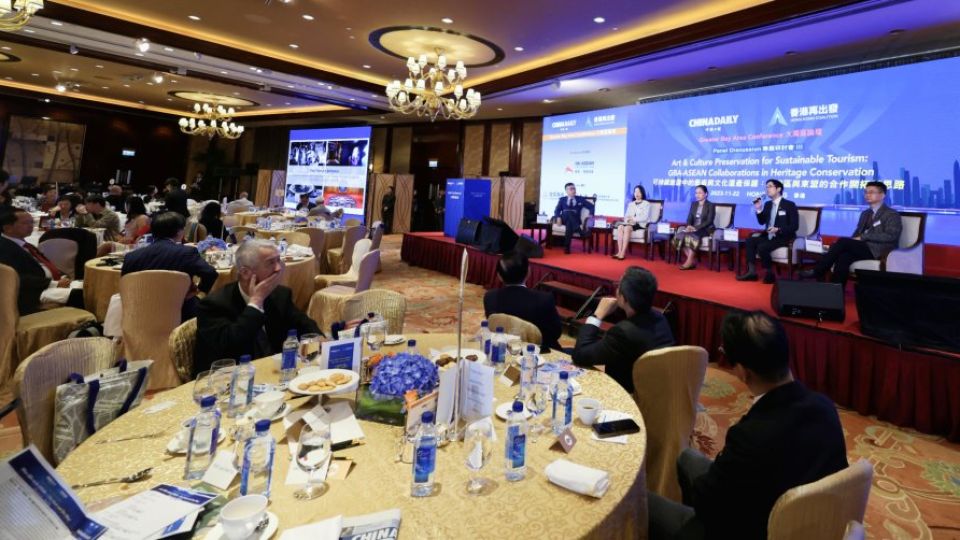November 23, 2023
HONG KONG – The Greater Bay Area (GBA) and the Association of Southeast Asian Nations (ASEAN) can deepen cooperation in heritage conservation to jointly promote sustainable tourism, officials and experts said at a conference on Nov 22.
“The Greater Bay Area is one of the centers of China’s economy,” said Darany Phommavongsa, director general of the Tourism Management Department of the Lao Ministry of Information, Culture, and Tourism.
Based on its strengths in the conservation and development of cultural tourism resources, Ma said her company is willing to promote cultural and tourism cooperation between the GBA and ASEAN
Laos stands ready to work closely with other ASEAN member states and the bloc’s dialogue partners, in particular China and its GBA city cluster, said Darany.
READ MORE: HK to ‘connect, add value’ to GBA-ASEAN collaboration
She was speaking at a panel themed “Art and Culture Preservation for Sustainable Tourism: GBA-ASEAN Collaborations in Heritage Conservation” during the Greater Bay Area Conference held in Hong Kong.
The conference was co-organized by China Daily and the Hong Kong Coalition.
Laos is set to become ASEAN chair next year and the “Visit Laos Year 2024” tourism promotion campaign will also be rolled out, Darany said.
She said the ministry looks forward to exchanging experiences on heritage conservation to learn from each other and to make full use of the region’s rich cultural heritage resources aimed at promoting sustainable tourism.
Darany noted that the China-Laos Railway will also help facilitate tourism exchange within ASEAN.
Ma Jin, deputy general manager in charge of the Cultural Tourism Product Development Center of China Travel International Investment HK, highlighted the company’s preservation of the Zuojiang Huashan Rock Art Cultural Landscape in Southwest China’s Guangxi Zhuang autonomous region.
The largest collection of rock art discovered in China so far has over 2,000 years of history and was listed as a UNESCO World Heritage Site in 2016.
“Culture and art is a bridge for communication,” said Ma, noting cultural heritage sites such as the Zuojiang Huashan Rock Art Cultural Landscape can also serve to connect China with Southeast Asia.
Chinese relics such as the bronze drum unearthed in countries like Vietnam, Myanmar, and Thailand are proof of the longstanding cultural communication between the two sides, Ma added.
Based on its strengths in the conservation and development of cultural tourism resources, Ma said her company is willing to promote cultural and tourism cooperation between the GBA and ASEAN.
Brian Yuen, deputy director of museum operations of the Hong Kong Palace Museum (HKPM), said there are three key principles when it comes to GBA-ASEAN cooperation in sustainable tourism and cultural heritage conservation — product, process, and people.
Opened to the public in July 2022, the HKPM presents over 900 treasures from the Palace Museum in Beijing and has welcomed more than 1.7 million visitors so far.
Yuen said it is important to make the exhibition products relevant to those who do not know about the culture while also engaging local people and artists, as well as different segments of the tourism industry, in the promotion process.
“We need to bring in ambassadors who are passionate about the culture,” Yuen said of his proposal.
Yuen noted that a team of a few hundred volunteers contributed a total of 30,000 volunteer hours to help the HKPM.
UNESCO Chair of Sustainable Tourism in UNESCO Designated Sites Zhang Chaozhi said it is important to find the right balance between tourism development and heritage conservation.
READ MORE: Green tech to ‘fuel high-quality growth’ in GBA, ASEAN
Organization is key, Zhang said. “Since we have to deal with so many tourists … we have to enhance our ability of management first.”
According to Zhang, it is also necessary to discuss the tolerance of locals to the commercial environment because people of different cultures and at different stages of development will have different levels of tolerance for tourism.
Desmond Hui, professor and head of the Art and Design Department of the Hang Seng University of Hong Kong, moderated the panel.


